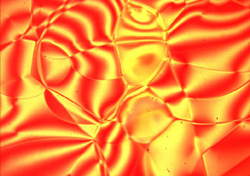Rod-like molecules will form either a nematic phase (molecules orient themselves in a preferred direction) or a smectic-type phase (molecules have a preferred direction and also arrange themselves into fluid-like layers). Some materials exhibit several different smectic phases at different temperatures. If the molecules are chiral they may exhibit ferroelectric or antiferroelectric-like behavior. Prof Hirst has previously investigated the structure of ferrielectric-like phases (also known as the intermediate phases) using resonant x-ray diffraction and microscopy. These studies lead to the elucidation of the structure of several smectic phases.

“Investigation into Liquid Crystalline SmC* Sub-phase Stability using Chiral and Achiral Dopants”
J. Kirchhoff and L.S. Hirst, PHYS. REV. E, 76, 051704 (2007). Link
“Resonant x-ray Scattering: a tool for structure elucidation in liquid crystals”
H.F.Gleeson and L.S. Hirst, CHEM PHYS CHEM, 7, 321-328 (2006)
“Interlayer structures of the chiral smectic liquid crystal phases revealed by x-ray resonant scattering”
L.S. Hirst, S.J.Watson, H.F.Gleeson, P. Cluzeau, P. Barois, R. Pindak, P. Mach, J. Pitney, P. Johnson, C.C. Huang, G. Srajer, J. Pollmann, A-M. Levelut, and W. Caleibe. PHYS. REV. E. 65 (4): art. no. 041705 Part 1 APR 2002 Link
“The influence of electric fields on the layer structure of antiferroelectric liquid crystal devices”
S.J. Watson, L.J. Baylis, L.S. Matkin, N. Bowring, H.F. Gleeson. PHYS. REV. E. 65 (3): art. no. 031705 Part 1 MAR 2002 Link
“Orientational ordering in the chiral SmC*FI2 liquid crystal phase determined by resonant polarised x-ray diffraction”
A. Cady, J.A. Pitney, R. Pindak, L.S. Matkin, S.J. Watson, H.F. Gleeson, P. Cluzeau, P. Barois, A-M. Levelut, W. Caleibe, J.W. Goodby, M. Hird and C.C. Huang, PHYS. REV. E. 64 (5): art. no. 050702 Part 1 NOV 2001 Link
A complete listing of the group’s publications can be found here.
